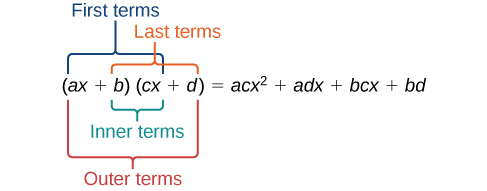Read: Sums and Products of Polynomials
Learning Objectives
- Add and subtract polynomials
- Find the product of polynomials
- Find the product of two binomials using the FOIL method
Add and Subtract Polynomials
We can add and subtract polynomials by combining like terms, which are terms that contain the same variables raised to the same exponents. For example, [latex]5{x}^{2}[/latex] and [latex]-2{x}^{2}[/latex] are like terms, and can be added to get [latex]3{x}^{2}[/latex], but [latex]3x[/latex] and [latex]3{x}^{2}[/latex] are not like terms, and therefore cannot be added.Example
Find the sum.[latex]\left(12{x}^{2}+9x - 21\right)+\left(4{x}^{3}+8{x}^{2}-5x+20\right)[/latex]
Answer:
[latex]\begin{array}{cc}4{x}^{3}+\left(12{x}^{2}+8{x}^{2}\right)+\left(9x - 5x\right)+\left(-21+20\right) \hfill & \text{Combine like terms}.\hfill \\ 4{x}^{3}+20{x}^{2}+4x - 1\hfill & \text{Simplify}.\hfill \end{array}[/latex]
Given multiple polynomials, add or subtract them to simplify the expressions.
- Combine like terms.
- Simplify and write in standard form.
Example
Find the difference.[latex]\left(7{x}^{4}-{x}^{2}+6x+1\right)-\left(5{x}^{3}-2{x}^{2}+3x+2\right)[/latex]
Answer:
[latex]\begin{array}{cc}7{x}^{4}-5{x}^{3}+\left(-{x}^{2}+2{x}^{2}\right)+\left(6x - 3x\right)+\left(1 - 2\right)\text{ }\hfill & \text{Combine like terms}.\hfill \\ 7{x}^{4}-5{x}^{3}+{x}^{2}+3x - 1\hfill & \text{Simplify}.\hfill \end{array}[/latex]
Analysis of the Solution
Note that finding the difference between two polynomials is the same as adding the opposite of the second polynomial to the first. In the following video we show more examples of adding and subtracting polynomials. https://youtu.be/jiq3toC7wGMMultiplying Polynomials
Multiplying polynomials is a bit more challenging than adding and subtracting polynomials. We must use the distributive property to multiply each term in the first polynomial by each term in the second polynomial. We then combine like terms. You may have used the distributive property to help you solve linear equations such as [latex]2\left(x+7\right)=21[/latex]. We can distribute the [latex]2[/latex] in [latex]2\left(x+7\right)[/latex] to obtain the equivalent expression [latex]2x+14[/latex]. When multiplying polynomials, the distributive property allows us to multiply each term of the first polynomial by each term of the second. We then add the products together and combine like terms to simplify. The following video will provide you with examples of using the distributive property to find the product of monomials and polynomials. https://youtu.be/bwTmApTV_8o Below is a summary of the steps we used to find the product of two polynomials using the distributive property.How To: Given the multiplication of two polynomials, use the distributive property to simplify the expression.
- Multiply each term of the first polynomial by each term of the second.
- Combine like terms.
- Simplify.
Using FOIL to Multiply Binomials
We can also use a shortcut called the FOIL method when multiplying binomials. It is called FOIL because we multiply the first terms, the outer terms, the inner terms, and then the last terms of each binomial. The FOIL method arises out of the distributive property. We are simply multiplying each term of the first binomial by each term of the second binomial, and then combining like terms.
The FOIL method arises out of the distributive property. We are simply multiplying each term of the first binomial by each term of the second binomial, and then combining like terms.
Example
Use FOIL to find the product. [latex](2x-18)(3x+3)[/latex]Answer:
Find the product of the first terms.
 Find the product of the outer terms.
Find the product of the outer terms.
 Find the product of the inner terms.
Find the product of the inner terms.
 Find the product of the last terms.
Find the product of the last terms.

[latex]\begin{array}{cc}6{x}^{2}+6x - 54x - 54\hfill & \text{Add the products}.\hfill \\ 6{x}^{2}+\left(6x - 54x\right)-54\hfill & \text{Combine like terms}.\hfill \\ 6{x}^{2}-48x - 54\hfill & \text{Simplify}.\hfill \end{array}[/latex]
How To: Given two binomials, use FOIL to simplify the expression.
- Multiply the first terms of each binomial.
- Multiply the outer terms of the binomials.
- Multiply the inner terms of the binomials.
- Multiply the last terms of each binomial.
- Add the products.
- Combine like terms and simplify.
Licenses & Attributions
CC licensed content, Original
- Ex: Multiplying Using the Distributive Property. Authored by: James Sousa (Mathispower4u.com) for Lumen Learning. License: CC BY: Attribution.
- Multiply Binomials Using An Area Model and Using Repeated Distribution. Authored by: James Sousa (Mathispower4u.com) for Lumen Learning. License: CC BY: Attribution.
- Revision and Adaptation. Provided by: Lumen Learning License: CC BY: Attribution.
- Multiply Binomials Using the FOIL Acronym. Authored by: James Sousa (Mathispower4u.com) for Lumen Learning. License: CC BY: Attribution.
CC licensed content, Shared previously
- College Algebra. Authored by: Abramson, Jay, et al.. Located at: https://cnx.org/contents/[email protected]:1/Preface. License: CC BY: Attribution. License terms: Download for free at: http://cnx.org/contents/[email protected]:1/Preface.
- Unit 11: Exponents and Polynomials, from Developmental Math: An Open Program. Provided by: Monterey Institute of Technology Located at: https://www.nroc.org/. License: CC BY: Attribution.
- Ex: Adding and Subtracting Polynomials. Authored by: James Sousa (Mathispower4u.com). License: CC BY: Attribution.
- Ex: Polynomial Multiplication Involving Binomials and Trinomials. Authored by: James Sousa (Mathispower4u.com) . License: CC BY: Attribution.
